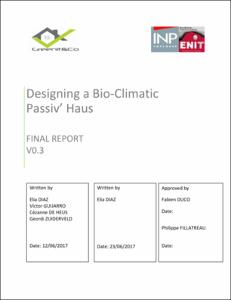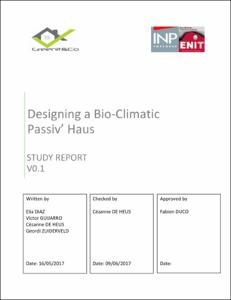Mostra el registre d'ítem simple
Designing a bio-climatic passiv’ haus
| dc.contributor | Duco, Fabien |
| dc.contributor | Fillatreau, Philippe |
| dc.contributor.author | Guijarro Monforte, Víctor |
| dc.date.accessioned | 2018-10-25T18:16:40Z |
| dc.date.available | 2018-10-25T18:16:40Z |
| dc.date.issued | 2017-06-23 |
| dc.identifier.uri | http://hdl.handle.net/2117/123029 |
| dc.description.abstract | The aim of the final report is to present the methods and show the results of the work done by the team during the EPS (European Project Semester) which consists of four months of work. The project consisted of designing a bio-climatic passive house in Labastide-Chalosse (Landes, France (40700)). It has been carried out by Greenit&Co which is a multicultural as well as a multidisciplinary team consisting of four students, the technical supervisor (Mr. Fabien DUCO) and the management supervisor (Mr. Philippe FILLATREAU). By designing a bio-climatic passive house the team has had to meet the requirements set by the Passive House Institute which is the official institution that is able to give the Passiv’ Haus certificate. These requirements have the aim of being respectful with the environment by using renewable energy, insulating it properly in order to avoid to have thermal bridges and consequently having a minimum consumption from the grid which can be at a maximum 15 kWh/m2/year. The passive house concerning this project will be a single-family house with a living space of 115 m2 and ground floor, the style of the living space must be “American” style, which means that there will be no walls between the kitchen, living room and dining room, this requirement is according to the client preferences. At the beginning of the project the team must set a planning in order to follow one schedule, taking into account all the probable risks, the deadlines and deliverables. Moreover the team must monitor this schedule to provide a clear overview about the current progress of the project and take the proper decisions. An extensive study is done by the team about the passive house in order to understand the main concept. The choice of materials to apply in the exterior envelope of the house must be the right one, because this can save cost in the long run by decreasing the heat load. The house systems used, which are systems for power generation, heating, ventilation and lighting, are studied to make sure that the decision taken by the team is the right one and consequently the passive house requirements and city regulations are met. Once the previously mentioned studies and choices are done a thermal simulation with Clima-Win™ is carried out to check if the team has been capable of designing a passive house by meeting all the requirements. Either those regarding the power consumption or those regarding the heating requirement. To conclude the project the conclusions are done in order to show how the project has been carried out, the difficulties found, the decisions taken and the final results. |
| dc.language.iso | eng |
| dc.publisher | Universitat Politècnica de Catalunya |
| dc.rights | Attribution-NonCommercial-ShareAlike 3.0 Spain |
| dc.rights.uri | http://creativecommons.org/licenses/by-nc-sa/3.0/es/ |
| dc.subject | Àrees temàtiques de la UPC::Enginyeria mecànica |
| dc.subject.lcsh | Sustainable construction |
| dc.title | Designing a bio-climatic passiv’ haus |
| dc.type | Bachelor thesis |
| dc.subject.lemac | Construcció sostenible |
| dc.subject.lemac | Edificis -- Estalvi d'energia |
| dc.subject.lemac | Energia -- Estalvi |
| dc.rights.access | Open Access |
| dc.audience.educationlevel | Grau |
| dc.audience.mediator | Escola d'Enginyeria de Barcelona Est |
| dc.audience.degree | GRAU EN ENGINYERIA MECÀNICA (Pla 2009) |
| dc.contributor.covenantee | SEAT S.A. |



